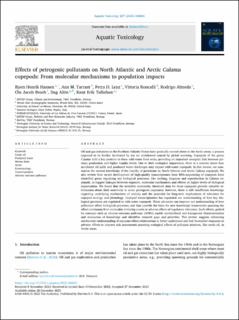| dc.contributor.author | Hansen, Bjørn Henrik | |
| dc.contributor.author | Tarrant, Ann M. | |
| dc.contributor.author | Lenz, Petra H. | |
| dc.contributor.author | Roncalli, Vittoria | |
| dc.contributor.author | Almeda, Rodrigo | |
| dc.contributor.author | Broch, Ole Jacob | |
| dc.contributor.author | Altin, Dag | |
| dc.contributor.author | Tollefsen, Knut-Erik | |
| dc.date.accessioned | 2024-02-05T10:12:41Z | |
| dc.date.available | 2024-02-05T10:12:41Z | |
| dc.date.created | 2024-01-30T14:16:31Z | |
| dc.date.issued | 2023 | |
| dc.identifier.citation | Aquatic Toxicology. 2023, 267 . | en_US |
| dc.identifier.issn | 0166-445X | |
| dc.identifier.uri | https://hdl.handle.net/11250/3115531 | |
| dc.description.abstract | Oil and gas industries in the Northern Atlantic Ocean have gradually moved closer to the Arctic areas, a process expected to be further facilitated by sea ice withdrawal caused by global warming. Copepods of the genus Calanus hold a key position in these cold-water food webs, providing an important energetic link between primary production and higher trophic levels. Due to their ecological importance, there is a concern about how accidental oil spills and produced water discharges may impact cold-water copepods. In this review, we summarize the current knowledge of the toxicity of petroleum on North Atlantic and Arctic Calanus copepods. We also review how recent development of high-quality transcriptomes from RNA-sequencing of copepods have identified genes regulating key biological processes, like molting, diapause and reproduction in Calanus copepods, to suggest linkages between exposure, molecular mechanisms and effects on higher levels of biological organization. We found that the available ecotoxicity threshold data for these copepods provide valuable information about their sensitivity to acute petrogenic exposures; however, there is still insufficient knowledge regarding underlying mechanisms of toxicity and the potential for long-term implications of relevance for copepod ecology and phenology. Copepod transcriptomics has expanded our understanding of how key biological processes are regulated in cold-water copepods. These advances can improve our understanding of how pollutants affect biological processes, and thus provide the basis for new knowledge frameworks spanning the effect continuum from molecular initiating events to adverse effects of regulatory relevance. Such efforts, guided by concepts such as adverse outcome pathways (AOPs), enable standardized and transparent characterization and evaluation of knowledge and identifies research gaps and priorities. This review suggests enhancing mechanistic understanding of exposure-effect relationships to better understand and link biomarker responses to adverse effects to improve risk assessments assessing ecological effects of pollutant mixtures, like crude oil, in Arctic areas. | |
| dc.language.iso | eng | en_US |
| dc.publisher | Elsevier | en_US |
| dc.rights | Navngivelse 4.0 Internasjonal | * |
| dc.rights.uri | http://creativecommons.org/licenses/by/4.0/deed.no | * |
| dc.title | Effects of petrogenic pollutants on North Atlantic and Arctic Calanus copepods: From molecular mechanisms to population impacts | en_US |
| dc.title.alternative | Effects of petrogenic pollutants on North Atlantic and Arctic Calanus copepods: From molecular mechanisms to population impacts | en_US |
| dc.type | Peer reviewed | en_US |
| dc.type | Journal article | en_US |
| dc.description.version | publishedVersion | |
| dc.source.pagenumber | 19 | en_US |
| dc.source.volume | 267 | en_US |
| dc.source.journal | Aquatic Toxicology | en_US |
| dc.identifier.doi | 10.1016/j.aquatox.2023.106825 | |
| dc.identifier.cristin | 2238417 | |
| dc.relation.project | Norges forskningsråd: 160016 | |
| dc.relation.project | Norges forskningsråd: 225314 | |
| dc.relation.project | Norges forskningsråd: 196711 | |
| dc.relation.project | Norges forskningsråd: 315969 | |
| cristin.ispublished | true | |
| cristin.fulltext | original | |
| cristin.qualitycode | 2 | |

